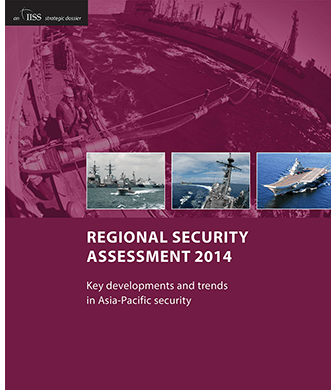Regional Security Assessment 2014: Key Developments and Trends in Asia-Pacific Security
Authors: Nina Hachigian
ISBN: 978-0860792109
Publisher: International Institute for Strategic Studies
Year: 2014
Reviewed by Kai Chen, Assistant Professor, School of International Relations, Xiamen University, China
In Regional Security Assessment 2014 by the seasoned scholars and analysts at the International Institute for Strategic Studies (IISS, one of the leading authorities on international strategies in the world), the editors and contributors to this book update the dynamics of the regional security situation, and analyze the strategic perspectives of the major powers (particularly the United States, China, Japan, India, Russia, Australia, South Korea, and ASEAN) in a changing security environment “marked by the rise of China and the central importance of the US-China relationship” (p.50).
This book features fourteen chapters, which cover the remaining challenges and unresolved issues in the Asia-Pacific region, such as the disputes in the East and South China seas, security situation in the Korean Peninsula, water security, climate security, energy supply, cyber threats, as well as arms competitions among the powers in this region.
The most significant contribution of this book is the incisive and thought-provoking analysis of the powers’ strategic perspectives in the coming future. As the contributors suggest, when China is not willing to replace the US as the dominant power in the Asia-Pacific region, the US should “continue reassuring its regional allies and partners of its commitment, while avoiding the risks of entrapment” (p.19). In the case of Korea peninsula, the US prefers to support South Korea to take the initiative in interacting with North Korea, rather than take an aggressive attitude toward North Korea.
As this book claims, three factors will play an increasingly important roles in shaping the direction China takes in the foreseeable future, that is, internal political dynamics (e.g., anti-corruption campaign), political-military relationships, and President Xi Jinping and his security advisers’ assessment of war and peace in the Asia-Pacific region.
Concerning Japan, South Korea and Australia, as the contributors analyze, the three countries’ security policies have been developing in an “evolutionary” pattern, which “remain no substitute for the regional presence and commitment” of the US (p.50).
In the eyes of the contributors, Russia has capabilities and willingness to take strategic risks when “it considers its interests threatened”. In the Asia-Pacific region, however, Russia’s strategic presence is limited for a certain time, because of the potential security crisis in East Europe, particularly the regions bordering Russia. Concerning India, it remains the largest arms importers in the world, in order to defend its interests and complicate other powers’ strategic calculations.
In contrast with the powers mentioned above, ASEAN might be the most complex power in the Asia-Pacific region, because it is composed of ten Southeast Asian countries, and has long struggled with insurgencies and transnational crime, which assume huge amount of human and financial resources. As a result, the defense programmes of ASEAN members remained “relatively small-scale”, except the case of Singapore, “where the primary focus has been on strengthening the air force” (p.184).
In short, Regional Security Assessment 2014 fits into a nice niche in both international strategies and regional security literature. This book will help anyone better understand the dynamics of security situation in the Asia-Pacific region.
Suggested citation:
Kai Chen (2015), Review of “Regional Security Assessment 2014: Key Developments and Trends in Asia-Pacific Security”, by the International Institute for Strategic Studies, 1st edition, East Asian Integration Studies. Vol 8, no. 8.



